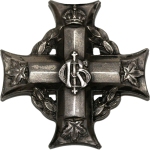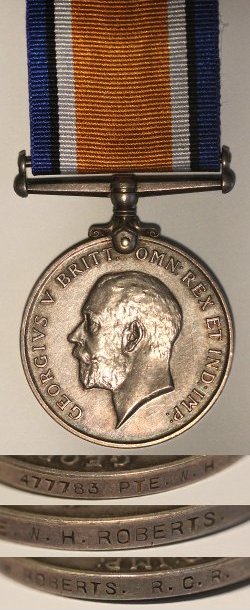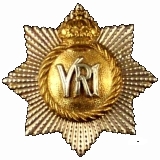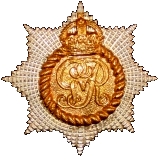

The First World War
Soldiers and Non-Commissioned Officers
of The Royal Canadian Regiment
477783 Private William Henry Roberts
By: Captain Michael O'Leary, The RCR

British War Medal awarded to 477783 Private William Henry Roberts.
William Henry Roberts was born at Dundee, Ayrshire, Scotland, on 18 Feb 1881. An emigrant to Canada, he enlisted in the Permanent Force on 12 Feb 1914, joining The Royal Canadian Regiment at Quebec, PQ. He was assigned the regimental number 8589.
William Roberts served in Canada and in Bermuda with the RCR, when the Regiment was despatched to that island for garrison duties in 1914-15. While in Bermuda, he would be admitted to hospital on 28 May 1915 at St George's, suffering from rheumatic fever. He would spend 15 days in hospital before being discharged to duty. In July 1915, while still in Bermuda, Roberts, along with the rest of the Regiment, was medically examined for later overseas service in Europe. Roberts was pronounced to be "Examined and fit for Active Service" on 14 July 1915.
Once back in Halifax in August 1915, it was required that the soldiers of The Rcr be reattested for overseas service with the Canadian Expeditionary Force. This was due to some concerns over the validity of their Permanent Force enlistments being applicable to such duties. Few men refused to re-attest and, on 22 Aug 15, William Roberts attests for overseas service with The RCR. On this attestation, he gave his civilian trade as bricklayer. Roberts was 34 years of age and described a 5' 6" tall, with a fair complexion, hazel eyes and light brown hair. He also identified that he had prior service with the 5th Regiment, Royal Highlanders of Canada.
When he attested for the CEF, Roberts identified Miss J. Rennie, of Montreal, as his next of kin, describing her as a friend. He also carried a pay assignment for $20 per month to her during his time overseas. Jessie Rennie is shown in the 1911 Canadian Census living at 125 Fulford St, Montreal, with her older sister Bella, a dressmaker. The younger Jessie was 23 at the time of the census, six years junior to William Roberts. She would also be the recipient of his medals after the war.
In late September 1915, Roberts' regimental number was replaced by the new CEF service number 477783 from the block of numbers assigned to the Regiment. With the rest of the Regiment, he entered France in the first days of November 1915. His service record is devoid of comment until the spring of the following year when, on 11 Apr 1916, he was granted nine days leave.
Roberts next service record entry shows that on 4 Jun 1916 he was admitted to No. 8 Field Ambulance Hospital with a bayonet wound to the chest. It is possible that he was wounded in action as early as 2 June when the Germans attacked the trenches held by the 7th Canadian Infantry Brigade. The Regiment's War Diary for the 2nd and 3rd of June provides the following details:
2.6.16. - Trenches
Weather fine. Night of 31st/1st very suspiciously quiet. At about 8.45 a.m. 2nd June enemy started violent bombardment which lasted about five hours. This was a concentrated bombardment principally directed on SANCTUARY WOOD and MAPLE COPSE. At about 3 p.m. the enemy attacked and drove our front line back which had been levelled to the ground. P.P.C.L.I. suffered tremendous losses their right being obliged to fall back on the Reserve line, but their left still held on to the APPENDIX thus keeping out right intact. The enemy made two attempts to come across to our trenches 70 to 74 but on both occasions were driven back the men behaving splendidly.
Reinforcements were sent up about 8. p.m., 60th, & 52nd Bns. And two Co's of K.R.R. These were sent into the "R" Line. A Counter attack was planned to commence at 2 a.m. 3rd inst. by the 69th Bn. (Col Griesbach) with the 52nd and 60th in support but owing to the latter Regiments not getting up in time it had to be postponed. At 5.30 p.m. one platoon under Lieut. Heron was sent to support P.P.C.L.I. on our right it arrived 6.05 P.M. under heavy shell fire but was told that its services would not be required. This platoon then returned. At 8.30 p.m. a terrific Artillery and rifle fire opened up again but lessened considerably about 9.15 p.m. and from then on steady Shrapnel fire continued on our support line. At 1.30 a.m. 3.6.16. a terrific bombardment commenced again.
3.6.16. - Trenches
Weather fine. Wind W. At 9. a.m. the enemy drove the remainder of the P.P.C.L.I. from the APPENDIX this leaving our right flank in the air.
Nothing of importance took place during the remainder of the day with the exception of the intermittent bombardments.
Lieut. F.R.L. De SALIS was killed by H.E. Shrapnel.
Lieut. E.E. McCALLUM was badly but not dangerously wounded while endeavouring to obtain information concerning the relative positions of the enemy's and our own line. He took two men with him, one of which was killed, the other badly wounded. The latter Lieut. McCALLUM bandaged as best he could and carried him back to R.H.Q. and then collapsed before his own wounds could be attended to.
Lieut. DAVIS was evacuated with shell shock.
'Great difficulty was experienced in evacuating the wounded even after dark but all were got safely out on this night.
There is also the possibility that Roberts was the two scouts who accompanied Lieutenant McCallum forward on 3 June to determine the relative locations of the front lines and brought back by him severely wounded. After nearly three weeks in the Field Ambulance Hospital, William Roberts was transferred to the No. 3 Divisional Rest Station on 24 Jun 1916. He was there for only four days before being returned to duty with the Regiment.
Roberts was wounded again on 16 Sep 1916, suffering a shot wound to his left hand. The generic description "shot wound" means the injury could have been caused by a bullet, or by shrapnel. The Regiment's War Diary provides a description of the actions taken by The RCR on 15, 16, 17 Sep 1916:
NARRATIVE OF EVENTS
15th, 16th & 17th September, 1916.
The Royal Canadian Regiment was bivouaced on the BRICKFIELDS (W.21.b) and at or about 9.15 a.m. on the 15th September 1916 order was received from the 7TH Canadian Infantry Brigade, commanded by Brigadier General A.C. Macdonell, C.M.G., D.S.O., to proceed at once to USNA HILL and there await further instructions.
The Regiment duly arrived at or about 11 a.m. and later on instructions were received for us to proceed to the CHALK PITS (X.10.c). At 6 p.m., the Regt. moved forward to Old British Line R.35.c.6.5. to R.34.b.4.5. with left flank on road in R.34.b.4.5. and again awaited further orders. We were the Reserve Battalion in the Bde. Bn. Hdqrs. were established in an open trench at R.35.c.1.8.
At 9.15 p.m. on the 15th the Bn. was distributed as follows:- reading from right to keft - "D" Co, Hdqrs, "A" Co, "C" Co., "B" Co. Up to this hour the casualties in the Bn. were about 15, including Lieuts. NAYLOR and BATE. The latter having his wound dressed returned to his Company with expedition. Rifle and M.G. fire were practically nil, but shellfire was very heavy, including all calibre. At 7.30 a.m. on the 16th Bn. Hdqrs were moved to a trench called CENTRE WAY (R.34.d.2.3.) in a deep dug-out.
At about 1. p.m. I received instructions to proceed to Brigade Hdqrs. and there received orders for the R.C.R. to attack the ZOLLERN GRABEN between points R.29.a.6.5. and R.29.a.2.8. The 42ND Bn. co-operated on our left. We also had instructions that, having gained the objective, we should bomb S.E. to junction FABECK GRABEN and establish touch with the P.P.C.L.I. who were operating on our right.
Zero time was 5. p.m. At this hour the Bn. was disposed as follows:- "A" Co. & "D" Co. in FABECK GRABEN, "C" Co. in SUGAR TRENCH, "B" Co. in OLD BRITISH TRENCH. The Artillery Barrage was to have commenced at 4.45 p.m., but according to reports the few shells that went over burst well in rear of the objective and caused practically no damage to the Hun, who was holding his line very thickly.
"A" and "D" Cos. advanced about 75 yds from FABECK GRABEN in the face of extremely heavy rifle and M.G. fire together with considerable artillery fire. The casualties were heavy and the advance was held up about 150 yds from the ZOLLERN GRABEN. At this juncture Lieut. PENNIMAN, finding himself alone and unable to find any other fit men near him, proceeded to a point about R.29.a.8.5. where the Regimental Bombers, together with the P.P.C.L.I. were bombing up the ZOLLERN GRABEN. Here I understand the machine gun which had done considerable damage to us was put out of action by our bombs. At 6.25 p.m. orders were received to move "C" & "B" Cos. to FABECK GRABEN at once. The Bn. was in position in and about the FABECK GRABEN until relieved by elements of the 52ND and 60TH Bns. at or about 4. a.m. on the morning of the 17th, when we proceeded to bivouacs at TARA HILL. The total casualties as far as can be ascertained amount to 1 Officer killed, 4 wounded and about 279 O.R. killed, wounded or missing.
(Sgd) C.H. Hill, Lieut Col.
Commanding The Royal Canadian Regiment
20/9/16
Roberts was evacuated and on 28 Sep 1916 was admitted to No. 2 Field Ambulance from which he returned to duty two days afterwards on 30 Sep. Having already been wounded in action twice and returned to his unit after each occasion, William Roberts' luck was not to hold. Within days he was in battle once again, and this time he would be as lucky. The regimental history describes the days after 1 Oct 1916 when The RCR relieved the 5th Canadian Mounted Rifles in the front lines near Zollern Graben. With "B" and "C" Companies in the front lines, "D" Company in Support in Zollern Graben and "A" Company in reserve 400 yards to the south:
"For two days, The Royal Canadian Regiment stood fast in these positions. Rain fell heavily at intervals, shelling was persistent, enemy machine-guns and snipers were active, and both sides launched bombing attacks at vulnerable points in the opposing line."
Perhaps he was captured by an enemy bombing party, or was wounded and unable to return to friendly lines after an RCR bombing raid. In any case, on 2 Oct 1916, William Roberts was reported "Missing After Action." In the normal course of events, as the Regiment waited to see if he would be identified as wounded and recovered to the medical system by another unit, or reported as captured, he was not actually recorded in the Regiment's Daily Orders as "Reported Missing After Action 2 Oct 1916" until D.O. Part II No. 78 dated 19 Dec 1916, and struck off strength accordingly. This order would subsequently be cancelled by another D.O. Part II dated 22 Dec and changed to "Died of Wounds whilst Prisoner of War at Parchim 22 Oct 1916."
On 22 Oct 16, Roberts died of a gun shot wound to the right hip. He was being held at the Parchim POW Camp at the time of his death. The POW camp at Parchim was located three miles outside the town of the same name in northern Germany. Parchim Camp had been built on a former cavalry drill ground and was set amidst pine woods, the camp enclosure bounded by a fence with three miles circumference. An inspection made of the camp in September, 1916, (quoted on the Great War Forum) provided the following regarding the camp's size:
"This camp has 46,000 prisoners on its books, and there are in all 1,900 prisoners of war in the camp proper, of whom 40 are British. 39,000 of the prisoners of war from this camp are employed at agriculture work, and 5,000 at industrial work. Of the prisoners in working camps there are 490 British and 130 of these are at the camp at Wasbeck."
A record of telegrams send regarding William Roberts survives in his service record. Among the notations on this hard is one, dated 18 Nov 1916, that provides the earliest indication of his fate. The text of the cable reads:
"With reference to my telegram 02310 Oct 6th reporting 477783 Pte Henry William Roberts wounded, further information from Base is lacking but unofficial owing to informality of Kommandanture Kriegsgefangenenlager Parchim states this soldier Died of Wounds Oct 22nd whilst Prisoner of War."
Roberts' record of service sheets note that on 6 Dec 16 he was listed as "Unofficially reported died of wounds on 22 Oct 1916 whilst a POW." A subsequent notation on 11 Dec 16 changed this to an official status.
In the Library and Archives Canada resides a collection of documents known as the Circumstances of Death records. There is a sheet there for Roberts, it reads simply:
"Died of Wounds" (Gunshot wound right hip) whilst prisoner of War at PARCHIM, GERMANY.
The form also provided his burial location as:
Parchim Prisoner of War Cemetery at SCHWERIN, 23 miles South East by East of SCHWERIN, GERMANY.
The Commonwealth War Graves Commission, in 1922-23, decided that the graves of Commonwealth servicemen who were buried in Germany would be brought together into four permanent cemeteries. As part of that initiative, Pte William Henry Roberts was one of the 83 graves relocated to the Hamburg Cemetery where he now lies at rest among nearly 2500 other Commonwealth soldiers, sailors and airmen of the First and Second World Wars. Two other soldiers of the Regiment are also buried in Hamburg Cemetery; Pte Fenwick Pernette and Pte Wilfred Stoodley.
Roberts left behind a brief soldier's will, which can be found in his service record. It states simply:
"In the event of my death, I give the whole of my property and effects to Miss J. Rennie, 125 Fulford St, Monteeal, P.Q., Canada."
It was signed Pte W.H. Roberts, No. 477783, and dated 23 March 1916.
Pro Patria
- The O'Leary Collection; Medals of The Royal Canadian Regiment.
- Researching Canadian Soldiers of the First World War
- Researching The Royal Canadian Regiment
- The RCR in the First World War
- Badges of The RCR
- The Senior Subaltern
- The Minute Book (blog)
- Rogue Papers
- Tactical Primers
- The Regimental Library
- Battle Honours
- Perpetuation of the CEF
- A Miscellany
- Quotes
- The Frontenac Times
- Site Map

![]() The RCR in the Great War
The RCR in the Great War
![]() War Diary
War Diary
![]() Battle Honours
Battle Honours
![]() Battle Bars and The RCR
Battle Bars and The RCR
![]() The RCR Battle Bar Ledger (pdf)
The RCR Battle Bar Ledger (pdf)
![]() Honours and Awards
Honours and Awards
![]() Roll of Honour
Roll of Honour
![]() Prisoners of War
Prisoners of War
![]() Cemetery List
Cemetery List
![]() Cemetery Map
Cemetery Map
![]() Courts Martial
Courts Martial
![]() Officers
Officers
![]() RSMs of The RCR (1914-1919)
RSMs of The RCR (1914-1919)
![]() NCOs and Soldiers
NCOs and Soldiers
![]() An Officer's Diary (1914-1918)
An Officer's Diary (1914-1918)
![]() Recollections of a Nonagenerian (R. England) (1916-1919)
Recollections of a Nonagenerian (R. England) (1916-1919)
![]() On to Bermuda (1914-15)
On to Bermuda (1914-15)
![]() England and France 1915-1916 (Hayes; 1931)
England and France 1915-1916 (Hayes; 1931)
![]() Overseas with The Royals (1915)
Overseas with The Royals (1915)
![]() Regimental History Pamphlet (1917)
Regimental History Pamphlet (1917)
![]() Amiens (1918)
Amiens (1918)
![]() Cambrai (1918)
Cambrai (1918)
![]() Monchy-le-Preux (1918)
Monchy-le-Preux (1918)
![]() Under-aged Soldiers in The RCR
Under-aged Soldiers in The RCR
![]() Not All Were Volunteers; The RCR and the Military Service Act
Not All Were Volunteers; The RCR and the Military Service Act
![]() Sentenced to Death by Court Martial
Sentenced to Death by Court Martial
![]() The 7th Trench Mortar Battery
The 7th Trench Mortar Battery
![]() A Regimental Goat
A Regimental Goat
![]() Regiment and Family, Bermuda 1914-15
Regiment and Family, Bermuda 1914-15
![]() "March the Guilty Bastard In"
"March the Guilty Bastard In"
![]() Surrendered as Stowaway
Surrendered as Stowaway
![]() Re-Visiting the Great War Roll of Honour for The RCR
Re-Visiting the Great War Roll of Honour for The RCR
![]() Canadian Corps Trench Standing Orders (1916)
Canadian Corps Trench Standing Orders (1916)

